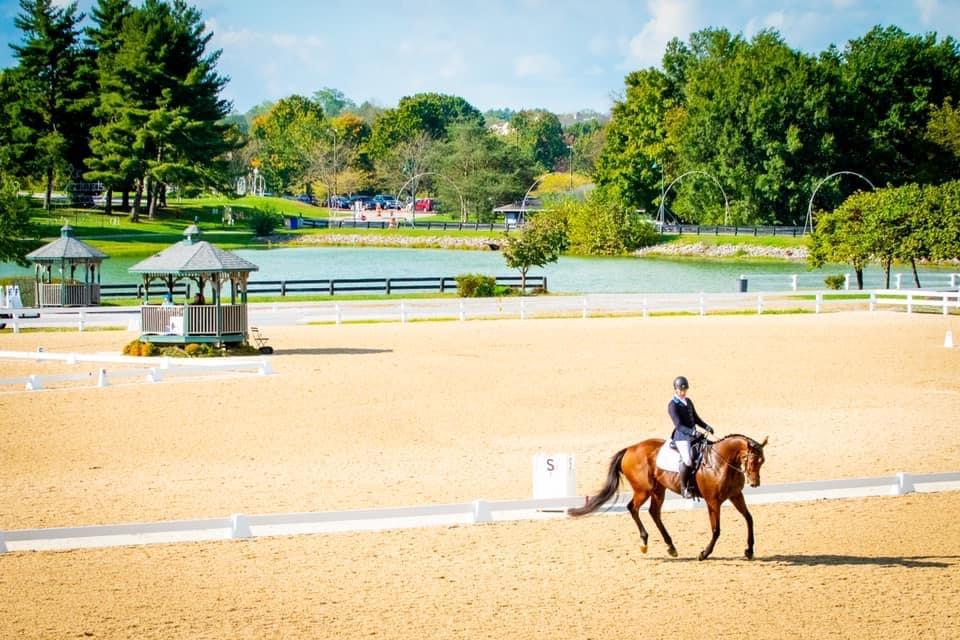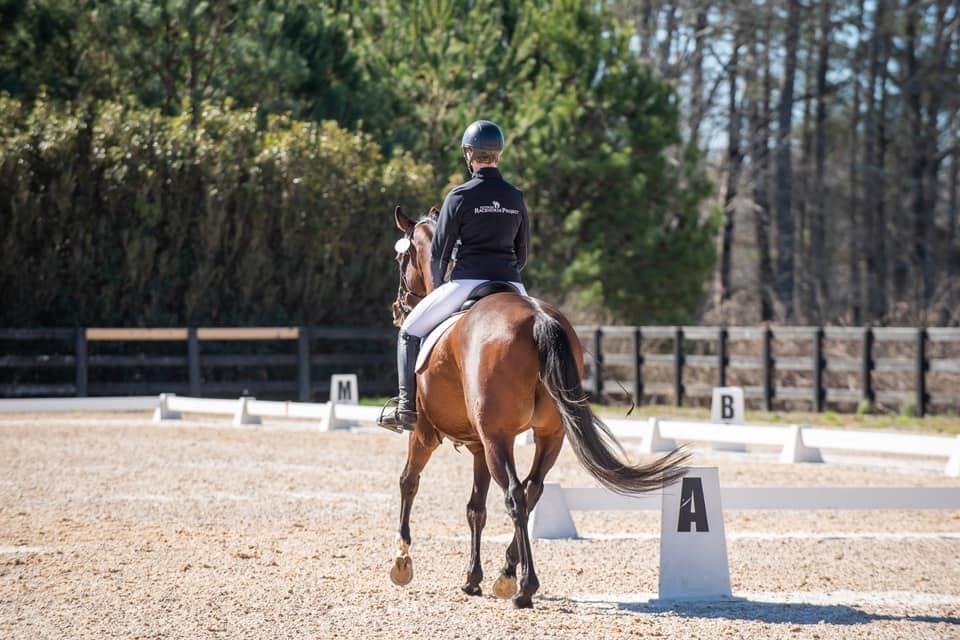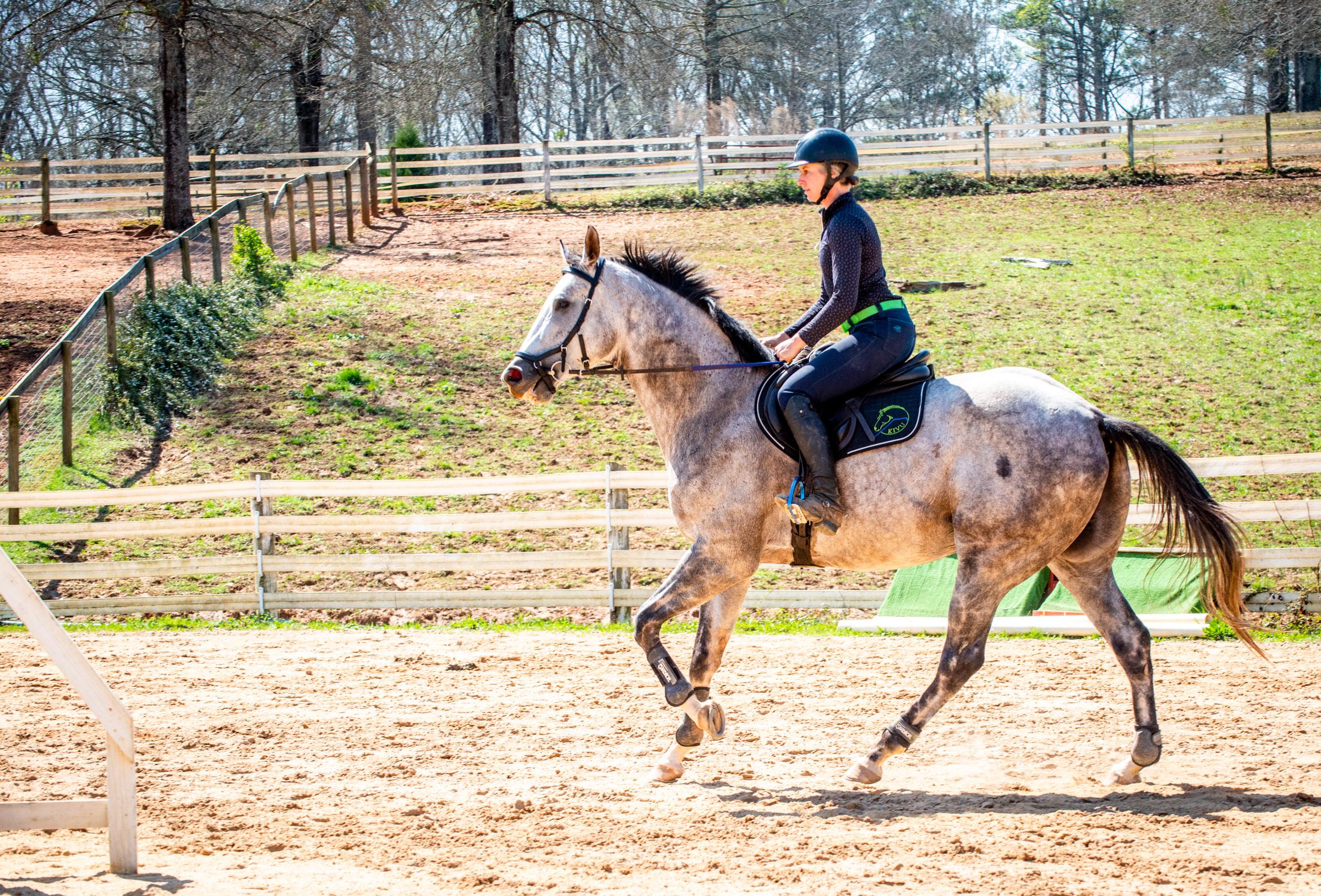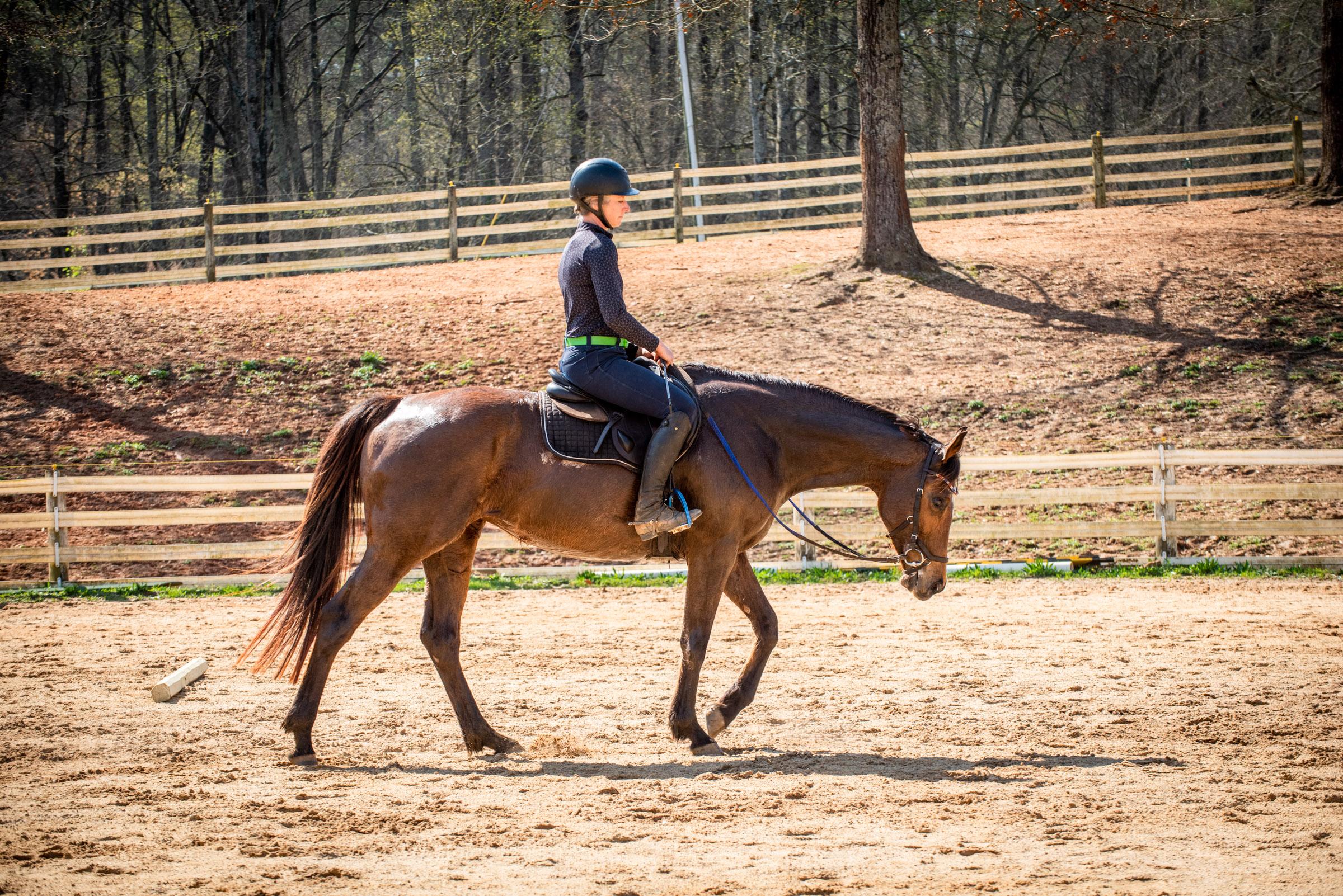
Thoroughbred Logic: Transitions & The Post
“The me who raced my redheaded Appendix down dirt roads and knew every stretch of potentially hundreds of miles of local trails, never gave one lick about whether or not he stayed obedient or balanced through his transition to canter. Turns out, I was missing out.”
Welcome to the next installment of Thoroughbred Logic. In this weekly series, Anthropologist and trainer Aubrey Graham, of Kivu Sport Horses, offers insight and training experience when it comes to working with Thoroughbreds (although much will apply to all breeds). This week, come along for the ride as Aubrey offers her logic on transitions and how to get your green horse driving from behind into the transition.
Like a lot of my students, I grew up with a mixed-bag background of equitation and hunters. I wish younger me knew that eventing existed when I quit the show ring to go ride endurance for a few years… oh well… I got here eventually. While I love the part where I get to gallop big solid objects, one of the amazing things about Eventing is the fact that dressage forces me to be a more conscientious, present rider.

Me on the left riding Copperfield with Bret Flower and Devon Poeta on a hunter pace in Connecticut circa 1998-ish? Photo courtesy of Devon Poeta.
No longer am I allowed to be two movements ahead of my horse. Nope. Until I pass the assigned letter, I have to live in that box and focus on the directions. The me who raced my redheaded Appendix down dirt roads and knew every stretch of potentially hundreds of miles of local trails, never gave one lick about whether or not he stayed obedient or balanced through his transition to canter. Turns out, I was missing out.

Vanderboom Ridge helped concretize my begrudged love of dressage as he prepared for the Retired Racehorse Project’s TB Makeover in 2021. Photo by Alexa Wegner.
For the last twenty-plus-years (well hell, I’m getting old) of being back in steady in-arena training, I have regularly found high quality transitions to be one of the hardest parts of flatwork. It is so easy to already be ahead of the horse mentally (and physically) and so set for the next gait that you (read: universal you) throw the transition out the window just to get into the trot or the canter. A common observation is that folks will “go trot” or “go canter” before they have prepared themselves or their horses. You’ll see this as they are leaning through the transition and then frantically trying to get their reins and adjust the pace once they are in the desired gait.
Ok sure, in dressage, this unprepared hustle will get you a lower score than a properly collected, put together transition — one that is prepared for the trot or the canter from the get go with no need to adjust the reins after arriving in the desired gait and no need to immediately adjust the tempo. Improving one’s scores are usually a good enough reason to work on things at home. But scores aside, and for those who don’t have to dance in the sandbox, there are seriously good reasons to think about transitions and to find ways to improve them.

Despite my standard Eventer love of “running and jumping big things,” Dressage has become a super helpful pursuit for improving my riding and staying present with the horse. Photo of Unbridled Bayou (Louis) by Cora Williamson.
Most of it comes down to balance and the hind leg (and particularly the hind outside leg). Poor transitions cast the horse onto their forehand. That can be a bit of a problem, as a horse on the forehand must use speed to balance themselves or will rely on the rider to hold their front end up. And for riders on green Thoroughbreds, that unbalanced speed might come with some serious miles per hour. And moreover, while initial rides on green horses should focus on getting a quiet rhythm in each gait, the transition is a place to set oneself up for success (or some version of the inverse).

Posting all transitions and balancing this big hunk of horse onto his outside leg kept Uno (Hold ‘Em Paul) from trying any shenanigans or trying to freight train away during his first post track ride. Photo by Alanah Giltmier.
Around here, I teach two main processes to simultaneously balance them over their hind leg and to avoid tossing them onto their forehand/gunning them into transitions:
- Post into it.
- Take your time.
- (OK OK, there are three and this one is critical, but we’re not addressing it today — train and utilize your half halts)
There are plenty of different views on this, but I personally, do not like to “sit” in any real, deep way on any green horse. I do a lot of hovering at the canter and happily post around in the trot. Walk? Well, I just try to stay light. Here’s why I don’t sit:

Uno posted himself into a light canter during his first post track ride, so I kept the contact as it was at the trot and hovered just above the saddle and let him remain quiet and calm in the new gait. Photo by Alanah Giltmier.
Racehorses generally are accustomed to having jockeys up and off their backs. They learn how to balance themselves and carry that weight with a ride “up.” When trying to go from a good trot to a good canter, I do the best I can to not change their balance. Sitting and generally pitching forward and using one’s seat to drive the canter changes their balance and often startles the ex-racehorse, causes them to hollow their back and throws them into more of a scramble-run than a canter. That run then requires the reins to slow down and the whole process has done little to teach quality gaits and quiet rhythmic movement.

Forrest (Don’t Knock It) breezing on the track for Tropical Racing back in 2017. Photo courtesy of Tropical Racing.
Posting into the transition on the other hand, helps a ton. That said, it sure looks funny and feels even worse for those not used to it. BUT, I promise it works. I simply ask for the canter while continuing to post, doing the best I can to keep myself upright and not “tip” or “pitch” while asking for the transition. Once they get the canter, I just stay on the up post and hover while they find their balance, maintain their outside hind leg power, and settle in. Generally, I do not need to do anything different with my reins — no pulling, no hard holding etc. I’m able to just carry with the same contact as the trot.

Staying up off of Wolf’s (Louisiana Moon) back on his first post-track ride helped him settle into a quiet, balanced canter. Yeah, yeah, yeah, you can tell I like this horse. Photo by Alanah Giltmier.
Similarly, on the down transition, I use my core to slow the horse, drop my tail bone and then as they listen, I start to post before the trot shows up. I do not sit the canter and go to my reins. Again, this sounds redundant, but basically, posting in and out the various gaits allows you to keep them on their hind end and maintain quiet contact without having to pull for a change of rhythm. The upside is not only do they learn to listen to your body as you shift between the various paces, but they also stay light on your hands and balanced “up” not “down.”
While productive, so much of this is simply awkward and seems super counterintuitive. Meh, such is horse training… I just own it.
One of the hardest transitions to nail in this method is from trot to walk. So often we all want to sit the trot, close our leg and seat and then ask for a walk through the reins. Riding enough off-trackers has taught me that as soon as you shift your balance and sit (even if you are a pro at staying upright), the weight change on their back causes them to pull down, hollow, or go faster… So this is where the ‘time’ comes in. I allow as long as necessary for a quiet transition. Like, if it needs to take 30 seconds to get there, great. Two minutes, fine. Whatever they need, they get. So as I trot along, tighten my core, and close my leg to ask for a down transition to walk, I keep lightly posting until they walk, starting with a hind foot.

Ellie (Lady Allyn) stretching in her walk during her first ride back to work here at Kivu. Photo by Alanah Giltmier.
If they brace their jaw and lean forward, I put leg back on and we return to trot. It does not take long when transitioning them through a slow, balanced trot for them to learn to sit and step from their hind end into the walk. But importantly, I will keep awkwardly posting until they are literally walking. Over time, this time consuming process fades out as they gain their balance, strength, and learn half halts. But for the first many rides, and for any horse who rushes, pulls down, or gets heavy in transitions, slowly posting them up or down into the new gait is shockingly effective.
Ok, thus concludes my “why I love posting” post. And for more nerd-tastic information on why we call it “posting,” check out this sweet article Horse Network put out a while back here. So go hop on and enjoy the post and what is hopefully some form of Spring warmth and sunshine.





